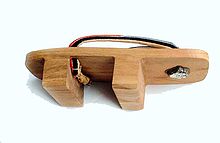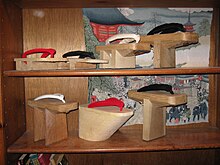Geta(footwear)
This article includes a list of generalreferences,butit lacks sufficient correspondinginline citations.(March 2019) |

Geta(Hạ đà)(pl.geta)[1]are traditionalJapanesefootwear resemblingflip-flops.A kind ofsandal,geta have a flat wooden base elevated with up to three (though commonly two) "teeth", held on the foot with a fabricthong,which keeps the foot raised above the ground.
History[edit]


The earliest known pair of geta was excavated in a neolithic archaeological site near Ningbo, Zhejiang,China,dated to theLiangzhu culture(3400–2250 BCE). These geta differed in construction to modern geta, having five or six holes in place of the modern-day three. The use and popularity of wooden clogs in China has been recorded in other sources dating to between theSpring and Autumn period(771–476 BCE) to theQin(221–206 BCE) andHan dynasties(202 BCE–220 CE). Geta-style shoes were worn in Southern China likely until sometime between theMing(1368–1644) andQing dynasties(1636/1644–1912), when they were replaced by other types of footwear.[2]
It is likely that geta originated from Southern China and were later exported to Japan. Examples of Japanese geta dating back to the latter part of theHeian period(794–1185) were found inAomoriin 2004, during an excavation along the right bank of the Shinjo river.[3]
Oiran(Hoa khôi)– high-rankingcourtesansof the feudal period inJapan– wore tall, lacqueredkoma-geta ormitsu-ashi(lit. 'three legs') when walking in a parade with their attendants. Whereasgeishaandmaikoworetabisocks,oiranchose not to, even in winter, as the bare foot against a lacquered clog was considered to be erotic, leaving the toes poking out under their expensive and highly decorated paddedkimono.
This style of geta was likely worn as a point of visual distinction betweenoiran,geisha and their apprentice geisha, as though the former entertained the upper classes, the latter did not, and were considered to be lower-class, despite their immense popularity.
Some seafood and fish merchants also used very high geta with particularly long teeth to keep their feet above any scraps of fish on the floor of their shops; these were known astengugeta.
Use[edit]

Geta are primarily worn withyukata,but sometimes also with Western clothing during the summer months. As geta are usually worn only withyukataor other informal Japanese clothes or Western clothes, there is no need to wear socks. Ordinarily, people wear slightly more formalzoriwhen wearingtabi.
Geta are worn with the foot overhanging the back and a finger-width of space between the strap and the skin webbing between the toes. The toes pinch the strap to lift the toe of the geta. Wearing them otherwise can make balancing more difficult and blisters more likely.[4]
In weather[edit]
Sometimes geta are worn in rain to keep the feet dry, due to their extra height and impermeability compared to other footwear such as zori. The inflexibility of geta means that water and dirt are not flipped up onto the back of the legs.
Geta are not normally worn in snow, because snow often gets stuck to the teeth of the geta, making it difficult to walk. However, in historical times, they were worn in the snow.
Geta may come with removable toe covers for use in cold, snow and rain. Some even come withice skatingblades.
Styles[edit]
There are several different styles of geta. The most familiar style consists of an unfinished wooden board called adai(Đài,lit. 'stand')that the foot is set upon, with a cloth thong (known as thehanao(Tị tự)) passing between the big toe and second toe.

The supporting blocks below the base boards, called theha(Xỉ,lit. 'tooth'),are also made of wood, usually very light-weightpaulowniawood (known askiri(Đồng)). If there are two "teeth", the forefront one is placed under the ball of the foot, and the geta pivots on it while walking, while the rear one is placed under the standing center of gravity.[5]The teeth make a distinctive "clacking" sound while walking, referred to askarankoron(カランコロン).This is sometimes mentioned as one of the sounds that older Japanese people miss most in modern life. A traditional saying in Japanese translates as "You don't know until you have worn geta." This means roughly, "you can't tell the results until the game is over."
The original motivation for wearing the high platform shoes was not fashion, but practicality: to keep feet and kimono from coming in contact with things on the ground, such as dirt, filth, water, or snow.
Thedaimay vary in shape, from oval shapes to more rectangular, with the former being considered more feminine and the latter more masculine. Geta also vary in colour from natural wood to lacquered or wood-stained varieties. Thehamay also vary in style; for example,tengugeta have only a single centered "tooth". There are also less common geta with three teeth.
Geisha[edit]
Maiko(geisha in training) wear distinctive tall geta calledokobo,which are similar to thechopinesworn inVeniceduring theRenaissance.Very young girls also wearokobo(also calledpokkuriandkoppori) that have a small bell inside a cavity in the thick sole. These geta have no teeth, but are formed of one piece of wood. The middle part is carved out from below and the front is sloped to accommodate for walking.
Okobofor young girls are usually red in color and are not worn withyukata,but a very fancy kimono, usually the bright, colourful kimono worn forShichi-Go-San.Okoboare usually worn withtabisocks.
Construction[edit]

Geta are made of one piece of solid wood forming the sole and two wooden blocks underneath. These blocks may have a metal plate on the section that touches the ground in order to lengthen the life span of the geta. A V-shaped thong of cloth forms the upper part of the sandal.
The teeth are usually not separate, instead, the geta is carved from one block of wood. Thetengutooth is, however, strengthened by a special attachment. The teeth of any geta may have harder wood drilled into the bottom to avoid splitting, and the soles of the teeth may have rubber soles glued onto them.
Thehanaocan be wide and padded, or narrow and hard, and can be made with many sorts of fabric. Printed cotton with traditional Japanese motifs is popular, but there are also geta with vinyl and leatherhanao.Inside thehanaois a cord (synthetic in modern times, but traditionallyhemp) that is knotted in a special way to the three holes of thedai.In the widehanaothere is some padding as well. Thehanaoare replaceable. It sits between the two first toes because having the thong of rectangular geta anywhere but the middle would result in the inner back corners of the geta colliding when walking.
Recently, as Western shoes have become more popular, more Western-looking geta have been developed. They are more round in shape, may have an ergonomically shapeddai,a thick heel as in Western clogs, instead of separate teeth, and the thong at the side as in flip-flops. According to Japanesesuperstition,breaking the thong on one's geta is considered very unlucky.[6]
See also[edit]
- Clog,comparison to similar shoes worldwide
- Flip-flops
- Jika-tabi,traditional split-toe Japanese boots
- Paduka,wooden sandals
- Patten (shoe)
- Tabi,traditional split-toe Japanese socks
- Waraji,sandals made from straw rope
- Zōri,another type of traditional Japanese footwear
References[edit]
- ^"Definition of GETA".www.merriam-webster.com.Retrieved2021-08-14.
- ^Mộc kịch tịnh bất thị nhật bổn nhân đích độc sang, trung quốc nhân xuyên mộc kịch đích lịch sử chí thiếu dĩ hữu tứ thiên đa niên liễu mộc kịch tịnh bất thị nhật bổn nhân đích độc sang, trung quốc nhân xuyên mộc kịch đích lịch sử chí thiếu dĩ hữu tứ thiên đa niên liễu[Clogs are not unique to the Japanese. The Chinese have worn clogs for at least four thousand years] (in Chinese).Archivedfrom the original on 17 May 2021.RetrievedMay 16,2021.
- ^Bình thành 16 niên độ thanh sâm thị tân điền (1) di tích hiện địa thuyết minh hội tốc báo[2004 Nitta, Aomori City (1) Breaking news of archaeological site information session] (in Japanese). November 2004.Archivedfrom the original on 17 May 2021.Retrieved17 May2021.
- ^"How to Properly Wear 'Geta'".All About Japan.16 October 2017.
- ^Wafuku (11 March 2009)."Traditional Japanese Footwear".Wafuku.
- ^Greve, Gabi (2016-06-10)."Edo – the EDOPEDIA -: geta wooden clogs".Edo – the EDOPEDIA -.Retrieved2019-02-21.
External links[edit]
- Edo – the EDOPEDIA: geta wooden clogs
- Wafuku blog about geta.Names and descriptions of all the types of Japanese geta, with photos.
- Japan Footwear Museum(in Japanese)
- The history of Japanese geta SandalsArchived2017-05-29 at theWayback Machine

